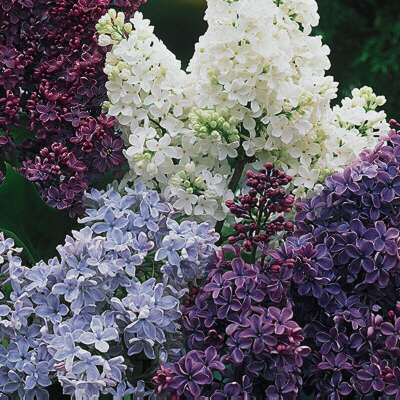Propagation of
French Hybrid Lilac (Syringa Vulgaris cvs.)
 |
Lilacs
are thought to have been brought to the United States as far back as the
sixteen and seventeen hundreds from Europe and Asia. There are even records
of George Washington and Thomas Jefferson growing lilacs in their gardens.
The common Lilac, Syringa vulgaris, originated in eastern Europe. The speices and its hybrids were among the most common used by French growers; hence they became known as the "French Hybrids". Lilacs are hearty in zones three, four and five. The plants grow best in full sun,with well drained alkaline soil with a pH of six to seven. Propagation is the production of plants through both sexual and asexual methods. Below is a discussion of the most popular methods for the propagation these lovely plants. |
Seed Propagation:
 |
The use of seeds for propagation is not the most popular method. But it is used to produce stock for grafting and also for producing hybrids. The Hybrid lilacs will not reproduce true from seed. However, it can be fun to try and see what you get. Lilac seeds will require fall planting or stratification of forty to sixty days at a temperature of four degrees Celsius. Stratification or a cold period removes the physiological dormancy of the seed and is required for seed germination. After the seed has sprouted take care of it as you would any other young seedling. |
Cutting Propagation:
| Propagation
by cuttings is probably the most popular and easiest method for gardeners.
Cuttings should be taken when new green terminal shoots are produced. They
should be four to six inches long. The cuttings should not be left out
too long, because they will wilt easily. The cuttings can be placed in
a media with peat, vermiculite and perlite. Most garden stores should have
a mix already made that is sutible. Minerals or fertilzers do not need
to be put in the mix, because they do not aid in rooting.
Indolebutyric acid (IBA) it the most popular synthetic rooting hormone to use because it is nontoxic to plants over a wide range of concentrations. It comes in either a powder or liquid form. If poweder is used make sure that the cutting is wet to assure that the powder adheres the the plant. It was found that IBA concentrations of 3000 to 8000 ppm were the best in effective rooting. You can try different concentrations and see which one works best for your plant. Each cutting should have nodes ( growing points where leaves were attached) on it and two or three leaves on top. The leaves aid in the rooting process by producing carbohydrates for the rooting plant. Place the cutting in the rooting media as deep at the leaves are. The cutting should never be allowed to dry out; misting is also a good idea. If they can not be misted, you can cover them with plastic to increase the humidity. If good growing conditions are kept up the plants should root within three to six weeks. Then you can plant them outside and enjoy. |
Grafting Propagation:
| Most
nursery stock producers use grafting to produce their plants. It is faster,
easier and more economical for them. Propagators use nurse-root grafting.
Privet or green ash root stock are used. The stock is the plant that is
the base and has the roots and the scion is theplant that is grafted on
top of the stock plant. However, the graft may show incompatibility symptoms,
but if the plant is planted deep enough roots will develop from the sicon
and become the dominant root structure. This kind of graft can cause problems
because of suckers from the stock plant. Therefore it is best to graft
lilacs on their own roots.
Most grafting is done during the winter on rootstocks that are grown for that specific purpose. It is best to use one year old root stock. The stock plants should be brought inside to perform the graft. Any number of different types of grafts can be used from the cleft graft to the whip-and-tongue grafts. The important thing is to remember to make sure the cambial layers of the both the stock and sicon are in contact. The cambial layer is the layer of growth and will be just inside the layer of bark tissue. After the graft is completed cover the area with grafting wax, special nursery adhesive tape, string, or rubber bands. Make sure to prune any suckers that might come from the stock plant. After the graft has healed make sure to remove the graft wrapping so that is does not constrict the growth of the plant. Then plant outside and enjoy. |
Sources:
| Hartmann T. Hudson, Kester E. Dale, Davies T. Fred. Plant Propagation: Principles and Practices. 5th ed. New Jersey: Prentice Hall, Inc., 1990. |  |